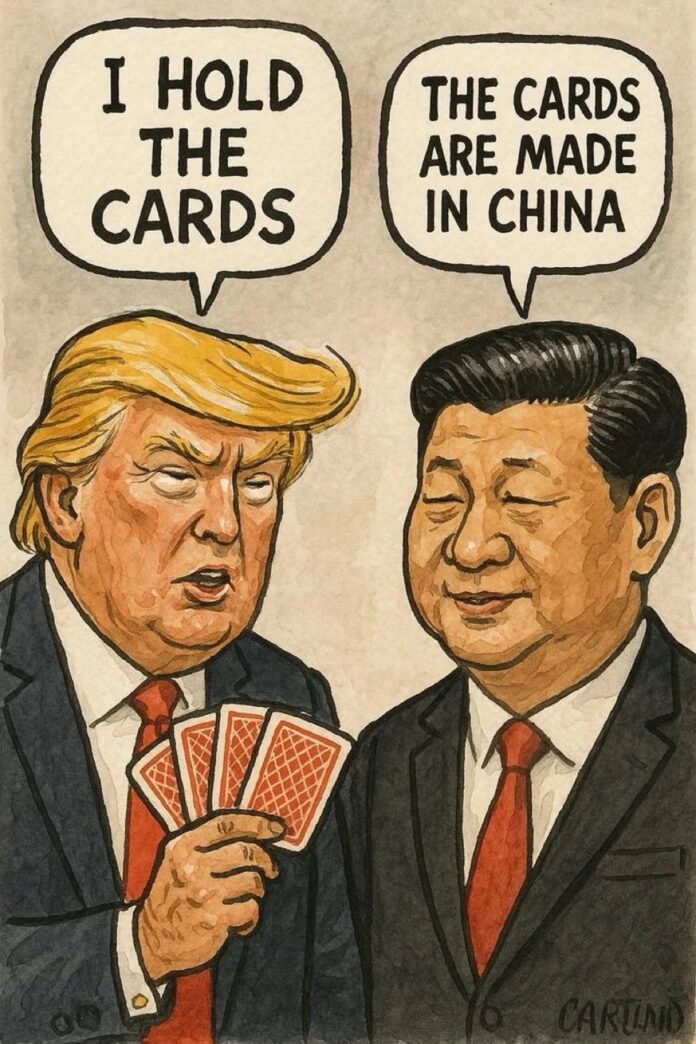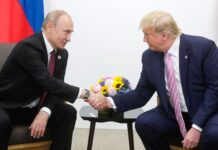The first of two articles on the ongoing trade standoff between the two biggest imperialist powers, China and the US
Vincent Kolo, chinaworker.info
A popular meme of Donald Trump and Xi Jinping is doing the rounds. Trump tells Xi, “I hold the cards”, and Xi replies, “The cards were made in China”.
According to some media reports, Trump and Xi will meet in South Korea at the end of October, their first meeting since 2019. This meeting is unlikely to announce a deal in the long-running economic conflict between the two countries, but may hail “progress” or claim that the trade talks are “moving along nicely” in Trump’s typically vague style, something the Chinese side will not object to.
But apart from a possibly imminent deal on TikTok, the Chinese-owned social media platform, a wider resolution of both sides’ differences is a long way off. A Trump-Xi meeting, during the Gyeongju APEC summit, will therefore mainly serve the immediate PR interests of both leaders, to reassure global capitalism and prolong their respective stock market bubbles.
There is a tendency in many Western media reports to overestimate China’s strength in the current trade conflict, which is part of a much bigger geostrategic and ‘hegemonic’ power struggle between the two biggest economies and imperialist powers.
A widely held view is that, while Trump’s aggressive and one-sided ‘America First’ tariff onslaught has largely succeeded in the short-term, imposing new and injurious terms on US allies such as the European Union, Canada and Japan, the Chinese regime has successfully stood up to Trump. This is not an accurate picture.
It is true that Beijing’s negotiators have succeeded in dragging out the talks from Geneva in May, to London in June, Stockholm in August, and most recently Madrid. This is a delaying tactic they employed very effectively during Trump’s first administration. The focus of the CCP (China’s so-called Communist Party) is to delay for as long as possible, hoping that Trump is weakened in next year’s mid-term elections in the US. This they hope will limit Trump’s control of trade policy, despite the fact that the Democrats are just as anti-China, if not more so, than Trump’s party.
But delay is not pain free. In the current US-China tariff truce, which began on 12 May, and was again extended for 90 days until 16 November, China’s exports to the US face an average tariff of 51%, a staggeringly high figure, compared to an average of 20% before Trump returned to power. China’s tariffs on US goods average 10 percent under the terms of this truce.
Strategic exaggeration
Mistaken approximations about Chinese power are common, partly due to the Xi regime’s strategic exaggeration with fake economic data concealing the real – dire – economic situation in China. Overseas media are often incapable of understanding how a capitalist dictatorship actually works and hampered by their earlier adulation of the CCP leaders as “brilliant” economic managers who in a former era made a lot of money for foreign capitalists. And it is not just about economic obfuscation. Beijing’s military parade on 3 September was also an exercise in projecting the CCP regime’s power – to the point of exaggeration.
Most of China’s military (PLA) tops seem to realise they cannot risk a war with US imperialism today, for example over Taiwan, because the “cards” are still stacked against China militarily. Rather than abandon the idea of “reunification” (a formal renunciation of this aim is virtually excluded), they would prefer to lower the military rhetoric and kick the Taiwan can down the road.
The CCP’s Taiwan problem – or more correctly its US problem – is an important factor in the internal CCP power struggle that is raging under the radar today, with the PLA leadership pushing back against Xi’s control. The CCP-capitalist elite has hemorrhaged billions of dollars in wealth as a result of the US-China conflict and China’s deep economic crisis, for which they hold Xi and his anti-Western ‘wolf warrior’ foreign policy responsible. Sections of the ruling elite would prefer an accommodation with US imperialism to gain an economic breathing space. But there is very little realism in this scenario even under a different CCP leadership. The imperialist conflict can be influenced by Trump, Xi, and other capitalist leaders, but it is not caused by them.
China’s share of global GDP has fallen from a peak of 18.5 percent in 2021 to around 16 percent this year. By comparison, the US economy’s share has inched ahead from 24.8 to 26.2 percent in the same period. This contradicts the ‘China Rising’ narrative we hear from the CCP and many foreign governments and militaries (who have many reasons to talk up the China threat). Several organisations on the left have also swallowed this narrative.
An additional factor is that prominent Western media commentators are desperate that something or somebody should ‘stop Trump’. They repeat that Trump is losing to China and that Trump’s policies are playing into China’s hands, in the hope of a return to pre-Trump policies in Washington.
But in fact, China (i.e. Chinese capitalism and the CCP dictatorship) is not winning the tariff confrontation. This is not due to Trump’s conduct of the struggle or his contradictory often self-defeating ‘tactics’, it is due to the unequal power relations. Trump’s tariff pain is piling further pressure on a Chinese economy that is flatlining under deflation, collapsing demand and a property sector crash that erased nearly twice as much household wealth as the US suffered in the 2008 banking crash. There is almost no combination of factors that could allow China to win this trade war. But – and this is the key point – Trump cannot win it either.
The CCP’s “cards” are weak, with a few exceptions like rare earth elements which are needed for Artificial Intelligence (AI) and in modern weapons systems and for which China holds a near global monopoly. Rare earths have become a crucial ingredient in the trade conflict – a “nuclear” weapon for the CCP. But for how long? This is a discussion in itself. For the first eight months of 2025, China’s rare earth exports have increased by 14.5%, a big jump. This is despite initially tough restrictions, as a weapon against Trump, which were then lifted by Beijing as part of the current truce.
Does Trump have a plan?
Trump’s trade war 2.0 is historic in reshaping the global capitalist economy and trading system, with the US in a dictatorial position lording it over other capitalist states. This was always the unspoken reality – such is the real nature of imperialism – but Trump has ended any ambiguity. The US president is like a feudal monarch imposing taxes on the rest of world capitalism, pushing the EU, Japan, Canada, Mexico and others into a relationship akin to tribute states.
The ‘taxes’ are mainly but not only in the form of new tariffs, such as the 15 percent on exports from the EU, while US goods to Europe face zero tariffs. Additionally, Trump has imposed trade quotas on many countries: conditions that they must buy a certain volume of American goods or face increased tariffs. And on top of this, Trump claims to have extracted promises for many billions – totally trillions of dollars – of new inward investment into the US. The deal being negotiated with South Korea’s government includes a US$350 billion package of promised investments in the US, while Japan has reportedly agreed a US$550 billion investment fund, which Trump claims his government will control. Despite these promises, Trump incensed South Korean society from top to bottom with the mass deportation of 300 South Korean workers from a Hyundai plant in Georgia in September.
Many of Trump’s so-called deals are more White House propaganda than formally ratified treaties. We will see what comes out of this process at the end. It is pointless to seek an economic rationale – “a plan” – behind Trump’s trade war policies. It is not about re-industrializing the US economy. Trump and a section of the US capitalists may believe they can do this, ironically by copying some of the CCP’s state capitalist industrial policies. Trump is increasing government involvement in various sectors from semiconductors to critical minerals. But the scale and pace of any re-industrialization will inevitably be limited.
In the longer run Trump’s policies will backfire catastrophically on US imperialism. They will massively undermine its alliance system built over 80 years to maintain US power over the global economy. They will loosen and possibly break the role of the US dollar as the linchpin of the global financial system. They will enormously damage the US economy, exacerbating its debt burden and triggering new financial crises.
But Trump’s policies are not about any long-term “plan”, they are about exercising power. Trump is leveraging in the most brutal and naked fashion the superior weight – economic and military – of US imperialism over lesser capitalist states. He is exacting a premium for the US in the context of the new era of imperialist bloc conflict, because for the capitalists in the advanced economies the “other side” (China and Russia) is worse.
These tactics have achieved short term “successes” because a large number of weak and terrified bourgeois regimes such as Taiwan’s William Lai and von der Leyen of the EU have capitulated and kowtowed to Trump. And the “opposition” on Trump’s home front from the Democratic Party has also been completely ineffectual.
The EU’s von der Leyen surrendered to Trump at negotiations in Scotland, accepting a deal that resembles the unequal treaties of China’s semicolonial past. The EU’s starting position was a “zero-for-zero” offer: no tariffs on either side. But they settled without a fight for Trump’s demand of “15-percent-for-zero”. An opinion poll (Cluster17) across the five biggest EU states found that 52 percent believed the deal was a “humiliation” and more than three-quarters were very or fairly dissatisfied with the EU’s approach. Even France’s far-right leader Marine Le Pen, the most pro-Trump politician in Europe, called the deal a “political, economic and moral fiasco”.
Why has the EU accepted such a humiliating deal? The answer is one word: Ukraine! The European governments fear losing Trump’s already shaky support for Zelensky in the war against Russia. Here we see how the Trump regime is leveraging US military power to coerce and extract economic concessions from its capitalist ‘friends’. EU governments need US arms and intelligence, even if they now have to pay the full cost.
CCP’s conduct of the trade war
On this count there is a fundamental difference with China. The CCP regime cannot be blackmailed in the same way with the threat of losing US military ‘protection’ which it of course never had. Therefore, given this different balance of forces, Trump is forced to adopt a different approach, while the economic gap between the two sides still gives Washington the upper hand.
Trump’s aggressive ‘splatter gun’ strategy to attack the whole world simultaneously has been a diplomatic disaster for the long-term interests of US imperialism. Under other circumstances it could and should have gifted Beijing with significant tactical advantages – to make economic and diplomatic headway with an array of governments alienated by Trump.
But the striking thing is how little, so far, the CCP regime has been able to gain at the expense of the US. Capitalist governments that have been hammered and humiliated by Trump’s officials are still yapping at the heels of their US “Daddy” – especially so in Europe. However much these leaders despise the new US regime, the geopolitical and economic threat coming from Beijing, not least its backing for Russia against NATO, is a bigger problem.
While Beijing has exploited Trump’s bully antics to further entrench itself as a leader of the Global South, increased political goodwill is not matched by tangible economic gains. China has achieved a limited economic rapprochement with Australia’s Labor government, but otherwise has made little headway in penetrating the US-led camp. Pew’s most recent surveys show some interesting shifts in public opinion (Xi Jinping is more trusted than Trump in Mexico, Canada, Germany and even narrowly in Sweden according to Pew Research). But unfortunately for the CCP, such sentiments cannot be turned into new export markets or meaningful diplomatic agreements.
Adding to the pressure on Beijing, Trump’s new tariff regime also targets third countries to punish so-called “transhipment” or “backdoors” that allow Chinese goods to avoid US tariffs. In dragooning these governments into fighting his trade war against China, Trump has scored some successes, the clearest example being Mexico, which recently imposed 50% tariffs on cars from China and other Asian countries in a policy clearly aimed at appeasing the US. Chinese brands account for one in five cars sold in Mexico this year.
Has China fought Trump more effectively than other governments? This is a widely held perception, but it is misleading. On one level we can say that the CCP’s negotiating tactics have been more skilful, especially in hiding its own weakness. This is not only to impress and wrongfoot the Americans, but also to maintain its control and image of invincibility over the Chinese population.
China’s export trap
Trump 2.0’s impact on China’s economy and global position is severe as we predicted. That a tariff ‘truce’ is in place is somewhat deceptive, given that China’s exports to the US are tariffed at five times the rate of US exports to China. The Chinese regime is practising the art of “eating bitterness”, showing the Chinese people’s allegedly greater capacity to endure hardship, to convey the message to Trump’s negotiators that it is in no hurry to make concessions.
The economic decoupling of the US and China is accelerating. In the first eight months of 2025, China’s exports to the US fell by 15.5 percent compared to the same period last year. In the same period exports to the EU rose 4.3 percent and to ASEAN (the 10-country bloc of Southeast Asia) increased by 9.7 percent. With Chinese economic growth having stalled badly, exports have become the economy’s main – almost the sole – support beam.
Overall, China’s exports have grown by 5.9 percent January-to-August despite a shrinking share of exports to the US market. This however hides many temporary factors such as ‘frontloading’ whereby companies build up stocks to try to get ahead of the changing tariff landscape. But in the next few years the problems for China’s export machine will only increase.
With its 30 percent share of world manufacturing, China’s economy is just too big to follow an “export-led” growth model. As it exports its surplus production at ever lower prices, other capitalist economies face being overwhelmed in a wave of Chinese-driven deindustrialisation. As The Economist (6 September) pointed out, an index of China’s export prices has fallen by 15 percent since 2022 even as exports have increased. This is the result of deflation and cutthroat price wars in China. These are so severe that even Xi, who until recently flatly denied there was any industrial overcapacity in China, has been forced to launch an “anti-involution” crackdown on price wars (which is unlikely to change much). Involution (neijuan in Chinese) refers to destructive competition, a race to the bottom.
It is already clear that Southeast Asia is in the grip of a deflationary “China shock” that is undermining the local capitalists and points to an increased protectionist backlash. No capitalist ever volunteered for extinction in the interests of “greater efficiency”. Each national capitalist regime will act to defend their own companies, banks and profits, while claiming they are acting to protect workers and jobs.
One of the factors behind Indonesia’s recent historic mass unrest is the decline of manufacturing in Southeast Asia’s biggest economy. Its manufacturing sector accounted for 32 percent of GDP in 2002, but barely half this figure today. Thailand and the Philippines have followed a similar trend although at a slower pace.
Here is the fundamental flaw in the CCP’s strategy to base its economic salvation on increased exports, diverted to the economies of the Global South to compensate for losing access to the US and other advanced capitalist markets. The most important of these is Southeast Asia which became China’s biggest export market (overtaking Europe and the US) in 2022. But the region’s role as an overspill for China’s surplus production is reaching its limits as economic slowdown and political unrest become unmistakable.
Trump’s threat of harsh “transhipment” tariffs hanging over many of these countries adds a new layer of problems for China’s exporters. Other markets such as Africa and the Middle East are not big enough to offset the loss of Western markets. The same is true of “no limits” Russia, which has this year imposed its own tariffs on Chinese imports.
The US-China imperialist conflict is the most glaring symptom of a world economic system experiencing its “death agony”. Their system offers only regression, ideological reaction including attacks on democratic rights, and a dogfight between the strongest economic powers to economically subjugate the rest.
The one force that offers a way out from this nightmare is not yet sufficiently organised or politically prepared. The international working class is a force far more powerful than all the Trumps and Xi Jinpings, but it is still emerging from several decades of disorganisation, political setbacks and the collapse of former mass parties. The task of Marxists and ISA is to assist the political awakening of the working class as an international force; to campaign for a new labour movement based on a clear working class and socialist alternative to capitalism and imperialism.




